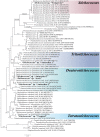Strong and widespread cycloheximide resistance in Stichococcus-like eukaryotic algal taxa
- PMID: 35058560
- PMCID: PMC8776791
- DOI: 10.1038/s41598-022-05116-y
Strong and widespread cycloheximide resistance in Stichococcus-like eukaryotic algal taxa
Abstract
This study was initiated following the serendipitous discovery of a unialgal culture of a Stichococcus-like green alga (Chlorophyta) newly isolated from soil collected on Signy Island (maritime Antarctica) in growth medium supplemented with 100 µg/mL cycloheximide (CHX, a widely used antibiotic active against most eukaryotes). In order to test the generality of CHX resistance in taxa originally identified as members of Stichococcus (the detailed taxonomic relationships within this group of algae have been updated since our study took place), six strains were studied: two strains isolated from recent substrate collections from Signy Island (maritime Antarctica) ("Antarctica" 1 and "Antarctica" 2), one isolated from this island about 50 years ago ("Antarctica" 3) and single Arctic ("Arctic"), temperate ("Temperate") and tropical ("Tropical") strains. The sensitivity of each strain towards CHX was compared by determining the minimum inhibitory concentration (MIC), and growth rate and lag time when exposed to different CHX concentrations. All strains except "Temperate" were highly resistant to CHX (MIC > 1000 µg/mL), while "Temperate" was resistant to 62.5 µg/mL (a concentration still considerably greater than any previously reported for algae). All highly resistant strains showed no significant differences in growth rate between control and treatment (1000 µg/mL CHX) conditions. Morphological examination suggested that four strains were consistent with the description of the species Stichococcus bacillaris while the remaining two conformed to S. mirabilis. However, based on sequence analyses and the recently available phylogeny, only one strain, "Temperate", was confirmed to be S. bacillaris, while "Tropical" represents the newly erected genus Tetratostichococcus, "Antarctica 1" Tritostichococcus, and "Antarctica 2", "Antarctica 3" and "Arctic" Deuterostichococcus. Both phylogenetic and CHX sensitivity analyses suggest that CHX resistance is potentially widespread within this group of algae.
© 2022. The Author(s).
Conflict of interest statement
The authors declare no competing interests.
Figures




Similar articles
-
Widespread green algae Chlorella and Stichococcus exhibit polar-temperate and tropical-temperate biogeography.FEMS Microbiol Ecol. 2016 Aug;92(8):fiw122. doi: 10.1093/femsec/fiw122. Epub 2016 Jun 7. FEMS Microbiol Ecol. 2016. PMID: 27279416
-
Temperature responses of growth, photosynthesis, fatty acid and nitrate reductase in Antarctic and temperate Stichococcus.Extremophiles. 2012 Jan;16(1):127-33. doi: 10.1007/s00792-011-0412-1. Epub 2011 Nov 15. Extremophiles. 2012. PMID: 22083129
-
Diversity and Ecology of Chlorophyta (Viridiplantae) Assemblages in Protected and Non-protected Sites in Deception Island (Antarctica, South Shetland Islands) Assessed Using an NGS Approach.Microb Ecol. 2021 Feb;81(2):323-334. doi: 10.1007/s00248-020-01584-9. Epub 2020 Aug 28. Microb Ecol. 2021. PMID: 32860076
-
Has resistance to chlorhexidine increased among clinically-relevant bacteria? A systematic review of time course and subpopulation data.PLoS One. 2021 Aug 19;16(8):e0256336. doi: 10.1371/journal.pone.0256336. eCollection 2021. PLoS One. 2021. PMID: 34411140 Free PMC article.
-
Viruses in Polar Lake and Soil Ecosystems.Adv Virus Res. 2018;101:39-54. doi: 10.1016/bs.aivir.2018.02.002. Epub 2018 Apr 26. Adv Virus Res. 2018. PMID: 29908593 Review.
Cited by
-
Metabolic complexity drives divergence in microbial communities.bioRxiv [Preprint]. 2023 Aug 3:2023.08.03.551516. doi: 10.1101/2023.08.03.551516. bioRxiv. 2023. Update in: Nat Ecol Evol. 2024 Aug;8(8):1493-1504. doi: 10.1038/s41559-024-02440-6. PMID: 37577626 Free PMC article. Updated. Preprint.
-
Metabolic complexity drives divergence in microbial communities.Nat Ecol Evol. 2024 Aug;8(8):1493-1504. doi: 10.1038/s41559-024-02440-6. Epub 2024 Jul 2. Nat Ecol Evol. 2024. PMID: 38956426
-
Harnessing Diesel-Degrading Potential of an Antarctic Microalga from Greenwich Island and Its Physiological Adaptation.Biology (Basel). 2023 Aug 17;12(8):1142. doi: 10.3390/biology12081142. Biology (Basel). 2023. PMID: 37627026 Free PMC article.
-
Selective degradation of hyperphosphorylated tau by proteolysis-targeting chimeras ameliorates cognitive function in Alzheimer's disease model mice.Front Pharmacol. 2024 Jun 11;15:1351792. doi: 10.3389/fphar.2024.1351792. eCollection 2024. Front Pharmacol. 2024. PMID: 38919259 Free PMC article.
-
Potential of Essential Oils from Cymbopogon winterianus Jowitt: Promising Evaluation for the Control of Mollusks and Embryos of Biomphalaria glabrata and Schistosoma mansoni Cercariae.Pharmaceuticals (Basel). 2025 Feb 25;18(3):318. doi: 10.3390/ph18030318. Pharmaceuticals (Basel). 2025. PMID: 40143097 Free PMC article.
References
Publication types
MeSH terms
Substances
Grants and funding
LinkOut - more resources
Full Text Sources

